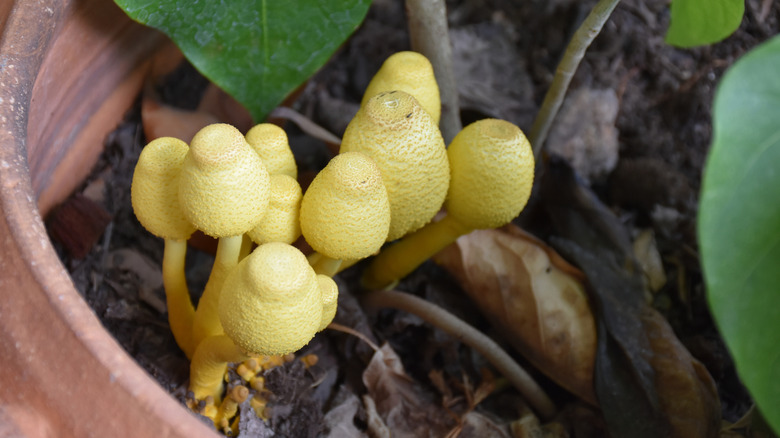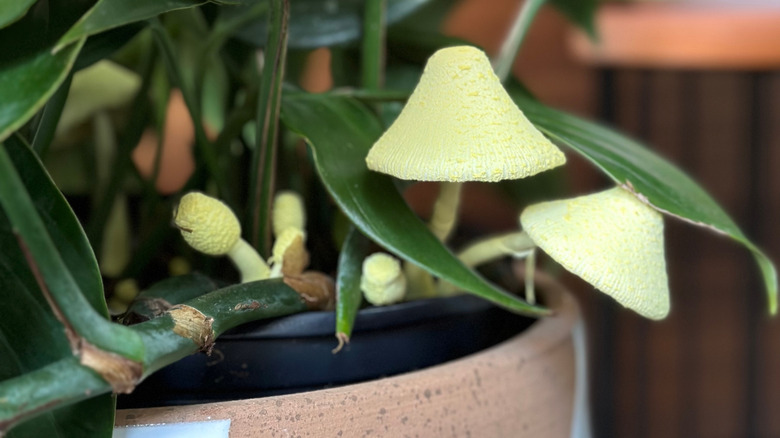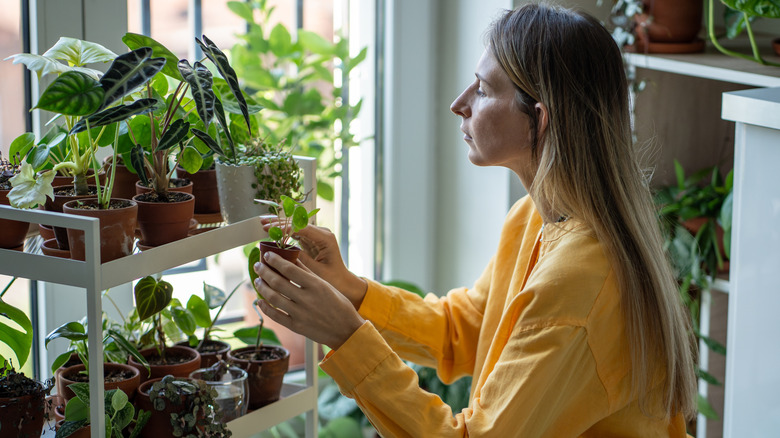A Smart Method For Removing Pesky Mushrooms From Your Houseplant's Soil
Mushrooms are fascinating, but we can all probably agree that there is a time and place for them. And usually, that is not in the soil of your houseplants. If mushrooms are the uninvited guest at your houseplant party, it can be pretty frustrating to see them pop up again and again. Although mushrooms often signify soil and plant health, there are a few common mushrooms that can crop up in houseplant soils that are actually poisonous. The yellow dapperling mushroom (Leucocoprinus birnbaumii) and the green-spored parasol mushroom (Chlorophyllum molybdites) are both toxic to humans and animals. So, to protect any children and pets in your home, it is best to remove them. Furthermore, the mycelium of certain fungi can form a dense mat that stops your plant from absorbing the nutrients and water it needs.
The easiest and simplest way of getting rid of mushrooms from your houseplants is by picking them out by hand. Then, changes to the soil and your plant care routine can stop the mushrooms from coming back. Although fungicide is an option for mushroom removal, it should be a last resort. You may wish to explore natural alternatives to store-bought fungicide, but you should contact your local county extension office for more information before applying any chemical products.
Pick the mushrooms out of houseplant soil by hand
To remove mushrooms from your houseplant's soil, you need to pick them off by hand. Be thorough when you are doing this, ensuring that you take every bit of the mushroom you can see. Once you have gotten all the mushrooms away from the potting media, throw them out. If you see any mycelium, remove that, too. Mycelium is usually hidden under the soil, but you may be able to see its furry, white, weblike structure. forming a layer on top of the potting soil.
Once that is done, you should aerate the top of the soil and apply a new top layer of mulch. However, if you see a lot of mycelium growing, it is best to change the soil completely. The mushroom spores will have hitchhiked into your home through the potting soil, and if they are really thriving, they will come back time and time again. By changing your indoor plant's soil, you can place it in potting media that is hopefully spore-free.
How to prevent mushrooms growing in houseplants
To prevent more from coming back, it is helpful to understand what it means if mushrooms are growing in your houseplants. Mushrooms tend to grow best when there is low lighting, high humidity, and warm temperatures. Too much water in the soil can also cause them to appear. So, you may need to change things up a little so the environment is not ideal for mushroom fruiting.
Since mushrooms are generally harmless, always consider the needs of your houseplant before making any changes. Like mushrooms, many houseplants thrive in warm, humid settings. So, you don't want to move them somewhere colder and drier to get rid of the mushrooms, only for them to die as well. That being said, conditions that are too hot and wet can cause a lot of issues for your plants. Fungi grow well in this kind of environment, but so do bacteria. If mushrooms are cropping up in your potting soil, consider your watering routine and the temperature of the location. These changes could also help you to avoid root or stem rot.


